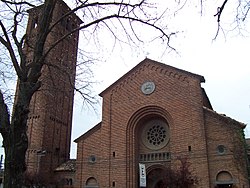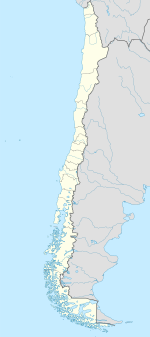world.wikisort.org - Chile
Linares is a Chilean city and commune located in the Maule Region and lies in the fertile Chilean Central Valley, 303 km (188 mi) south of Santiago and 50 km (31 mi) south of Talca, the regional capital. Linares is the capital city of the province of Linares.
Linares
Linarense | |
|---|---|
City and Commune | |
 Cathedral of Linares | |
 Flag  Coat of arms  Location in the Maule Region  Linares Location in Chile | |
| Coordinates: 35°51′S 71°36′W | |
| Country | Chile |
| Region | Maule |
| Province | Linares |
| Founded | May 23, 1794 |
| Founded as | Villa de San Ambrosio de Linares |
| Government | |
| • Type | Municipality |
| • Alcalde | Rolando Rentería Molina |
| Area | |
| • Total | 1,456.7 km2 (562.4 sq mi) |
| Elevation | 165 m (541 ft) |
| Population (2012 Census).[2] | |
| • Total | 120,716 |
| • Density | 83/km2 (210/sq mi) |
| • Urban | 10,000 |
| • Rural | 20,716 |
| Demonym | Linarense |
| Sex | |
| • Men | 55000 |
| • Women | 65000 |
| Time zone | UTC-4 (CLT[3]) |
| • Summer (DST) | UTC-3 (CLST[4]) |
| Postal code | 3580000 |
| Area code | 56 + 73 |
| Climate | Csb |
| Website | Official website (in Spanish) |
Demographics
According to the 2002 census of the National Statistics Institute, Linares spans an area of 1,456.7 km2 (562 sq mi) and has 83,249 inhabitants (40,518 men and 42,731 women). Of these, 68,224 (82%) lived in urban areas and 15,025 (18%) in rural areas. The population grew by 7.7% (5,933 persons) between the 1992 and 2002 censuses.[2]
Geography
The municipality covers an area of 1,466 km2 (566 sq mi) and the city proper, 16 km2 (6 sq mi). The rivers Ancoa, Putagán and Achibueno are the main rivers that pass through the municipality or form its natural borders.
Most of the territory of the municipality is located within the central plain or "depresión intermedia" (Valle Central de Chile). Some low altitude hills are located in the westernmost part of the municipality, while its easternmost part is marked by the presence of the foothills of the Andes mountains. The municipality of Linares is bordered on the west by San Javier; on the north by Villa Alegre, Yerbas Buenas and Colbún; on the east, by Colbún, and on the south, by Longaví. The municipality of Colbún occupies the easternmost strip of the province, where some of the highest provincial peaks are located, as are the sources of several of the main rivers.
Climate
Linares has a mild mediterranean climate (Köppen: Csb). The summers are hot and mainly dry (November to March) with temperatures reaching up to 32 -33 degrees Celsius on the hottest days. The winters (late May to mid September) tend to be rather humid and rainy, with typical maximum daily temperatures of 14-15 degrees Celsius, and minimum just above freezing.
| Month | Jan | Feb | Mar | Apr | May | Jun | Jul | Aug | Sep | Oct | Nov | Dec | Year |
|---|---|---|---|---|---|---|---|---|---|---|---|---|---|
| Avg temp. °F (°C) | 70 (21) |
69 (21) |
63 (17) |
57 (14) |
52 (11) |
48 (9) |
47 (8) |
49 (9) |
52 (11) |
57 (14) |
62 (17) |
68 (20) |
58 (14) |
| Avg high °F (°C) | 87 (31) |
85 (29) |
78 (26) |
70 (21) |
61 (16) |
55 (13) |
55 (13) |
58 (14) |
63 (17) |
69 (21) |
76 (24) |
83 (28) |
70 (21) |
| Avg low temperature °F (°C) | 54 (12) |
54 (12) |
49 (9) |
44 (7) |
44 (7) |
42 (6) |
39 (4) |
40 (4) |
42 (6) |
46 (8) |
49 (9) |
54 (12) |
46 (8) |
| Rainfall inches (millimeters) | 0.4 (10) |
0.1 (3) |
0.8 (20) |
1.8 (45) |
6.4 (163) |
7.3 (187) |
8.1 (206) |
4.0 (61) |
3.3 (83) |
0,8 (20) |
0,5 (13) |
0,3 (8) |
27.4 (694.13) |
| Source: Weatherbase | |||||||||||||
History and current status

Linares was founded on May 23, 1794, as the "Villa de San Ambrosio de Linares" by Ambrosio O'Higgins, the then Viceroy of Peru and Bernardo O'Higgins's father. The city counts among its natives important statesmen, politicians, poets, writers, and musicians and is an active commercial, agricultural, industrial, and service center.
The city of Linares houses the artillery school of the Chilean Army.
From 1913 to 1954 Linares had a station on the narrow gauge Putagán—Colbún railway line between Linares and Colbún.
Religion
According to the 2002 census of the municipality of Linares, 75.41% (or 45,987 persons) of the total population aged 15 and older identified themselves as Roman Catholic; 15.74% described themselves as evangelical Protestants; and 0.61% as Jehovah's Witnesses. Additionally, 2.00% of the total population aged 15 and older identified themselves as Mormons, approximately 2.59% declared themselves followers of other religions, and 4.95% of the population declared themselves atheist or agnostic.
Linares is a see of a diocese of the Roman Catholic Church, with nine active parishes and many chapels in the comuna. There are also many churches that serve the various Protestant denominations and places of worship for Jehovah's Witnesses or Mormons.
Main sights
The city and its surroundings have many attractions, for example:
- The Cathedral Church of San Ambrosio de Linares. This is one of the finest religious buildings built in Chile in the 20th Century. It was conceived after the Basilica of Saint Ambrose, in Milan, a noble building in the Romanesque style. The Cathedral of Linares was built after the old cathedral had been destroyed by an earthquake. Mgr. Juan Subercaseaux Errázuriz, a visionary churchman and second bishop of the Diocese of Linares, was the bright mind that conceived the new Cathedral and gave beginning to its works.
- The parish church, Corazón de María — a church declared a National Monument for its Gothic style and beauty
- The "Museo de Arte y Artesanía" (Museum of Arts and Crafts)
- Some old houses of colonial style
- A main library
Some natural attractions in the surrounding area include the piedmont of the Andes mountains, with forests of pines and other trees; lakes (the artificial Colbún lake); rivers, and good camping and hiking areas.
Other cities and towns in the province include: Colbún, Panimávida, Longaví, Parral, Retiro, San Javier, Villa Alegre and Yerbas Buenas.
Administration
As a commune, Linares is a third-level administrative division of Chile administered by a municipal council, headed by an alcalde who is directly elected every four years. The 2021-2025 alcalde is Mario Meza.[1]
Within the electoral divisions of Chile, Linares is represented in the Chamber of Deputies by Jorge Tarud (PPD) and Romilio Gutiérrez (UDI) as part of the 39th electoral district, together with Colbún, San Javier, Villa Alegre and Yerbas Buenas. The commune is represented in the Senate by Hernán Larraín (UDI) and Ximena Rincón González (PDC) as part of the 11th senatorial constituency (Maule-South).
Corruption under investigation
In August 2021 the Brigade against Economic Crime PDI in investigating embezzlement and fraud.[5]
In August 2021 the Comptroller General of the Republic indicated disproportional costs for over CLP$73million, currently under investigation for chlorine and rapid antigen test during the Covid pandemic.[6]
Economy
Linares is an important agricultural, industrial and financial center of the region.[1]
Notable natives and residents of Linares (city and province)
- Juan Ignacio Molina (Abate Molina), a Chilean priest and naturalist, born in Guaraculén, a farm located in Villa Alegre comuna.
- Carlos Ibáñez del Campo, Army General and twice the President of Chile;
- Arturo Alessandri Palma, politician, statesman and twice the President of Chile
- Valentin Letelier, educator, writer and politician
- Pedro Dartnell, General, Army commander-in-chief and politician
- Ismael Fuentes, footballer
- Manuel Miquel Rodríguez, politician
- José Manuel Sánchez, cofounder of Poliglota
- Sebastián Silva (basketball)
Artists and intellectuals
- Pablo Neruda, poet and Nobel Prize winner, born in Parral, Linares Province
- Margot Loyola Palacios, folk musician and researcher
- Edilberto Domarchi Villagra, poet
- Samuel Maldonado Silva,[7] poet, novelist and Journalist[8]
- Pedro Olmos, painter[9]
- Manuel Francisco Mesa Seco, poet and writer
- Eduardo Anguita, writer
- Rubén Campos Aragón, poet
- Max Jara, poet
- Jerónimo Lagos Lisboa, poet
- Gustavo González Rodríguez, journalist and university professor
- Juan Enrique Coeymans Avaria, civil engineer, PhD and university professor.
- Manuel Astica Fuentes, writer
- Faruk Jose Nome Aguilera[10] - professor of organic chemistry, Universidade Federal de Santa Catarina, Brasil.
- Humberto Pinochet, painter now living in Canada
- Juan Cristobal Pinochet, painter now living in Canada
See also
References
- "Municipality of Linares" (in Spanish). Retrieved 1 January 2011.
- "National Statistics Institute" (in Spanish). Retrieved 16 January 2010.
- "Chile Time". WorldTimeZones.org. Archived from the original on 2007-09-11. Retrieved 2007-05-05.
- "Chile Summer Time". WorldTimeZones.org. Archived from the original on 2007-09-11. Retrieved 2007-05-05.
- "Fraude al fisco, malversación de caudales y falsificación de instrumento público es lo que investiga la Fiscalía en la Municipalidad de Linares..." (in Spanish). Linares. 20 August 2021. Retrieved 20 August 2021..
- "Sin cotizar: Municipio de Linares pagó $73,6 millones de más en compras por pandemia" (in Spanish). Linares. 5 August 2021. Retrieved 5 August 2021.
- "Samuel Maldonado Silva".
- "Samy Silva".
- "Vida de Pedro Olmos".
- "PPGQ | Pós-Graduação em Química".
External links
- (in Spanish) Samuel Maldonado Silva Biography
- (in Spanish) Municipality of Linares
- (in Spanish) Museum of Arts and Crafts/Museo de Arte y Artesanía
- (in Spanish) Diocese of Linares
- Aerial photo # 1 from Google Maps
- Aerial photo # 2 from Google Maps
- Aerial photo # 3 from Google Maps. The westernmost portion of Linares comuna, lying between the rives Putagán (north), Loncomilla, (west) and Achibueno (south).
- Linares in Multimap
На других языках
[de] Linares (Chile)
Linares ist eine Stadt in der Mitte Chiles in der Región del Maule. Sie hat 93.602 Einwohner (Stand: 2017).[1] Es gibt viele berühmte chilenische Politiker, Dichter, Schriftsteller und Musiker, die in der Stadt geboren wurden. Heutzutage ist die Stadt Mittelpunkt von Handel, Agrarwirtschaft und Serviceleistungen.- [en] Linares, Chile
[ru] Линарес (Чили)
Линарес (исп. Linares) — город в Чили. Административный центр одноимённой коммуны и провинции Линарес. Население — 65133 человек (2002). Город и коммуна входит в состав провинции Линарес и области Мауле.Другой контент может иметь иную лицензию. Перед использованием материалов сайта WikiSort.org внимательно изучите правила лицензирования конкретных элементов наполнения сайта.
WikiSort.org - проект по пересортировке и дополнению контента Википедии
